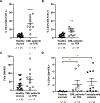Cytotoxic cell populations developed during treatment with tyrosine kinase inhibitors protect autologous CD4+ T cells from HIV-1 infection
- PMID: 32828803
- PMCID: PMC7686055
- DOI: 10.1016/j.bcp.2020.114203
Cytotoxic cell populations developed during treatment with tyrosine kinase inhibitors protect autologous CD4+ T cells from HIV-1 infection
Abstract
Tyrosine kinase inhibitors (TKIs) are successfully used in clinic to treat chronic myeloid leukemia (CML). Our group previously described that CD4+ T cells from patients with CML on treatment with TKIs such as dasatinib were resistant to HIV-1 infection ex vivo. The main mechanism for this antiviral activity was primarily based on the inhibition of SAMHD1 phosphorylation, which preserves the activity against HIV-1 of this innate immune factor. Approximately 50% CML patients who achieved a deep molecular response (DMR) may safely withdraw TKI treatment without molecular recurrence. Therefore, it has been speculated that TKIs may induce a potent antileukemic response that is maintained in most patients even one year after treatment interruption (TI). Subsequent to in vitro T-cell activation, we observed that SAMHD1 was phosphorylated in CD4+ T cells from CML patients who withdrew TKI treatment more than one year earlier, which indicated that these cells were now susceptible to HIV-1 infection. Importantly, these patients were seronegative for HIV-1 and seropositive for cytomegalovirus (CMV), but without CMV viremia. Although activated CD4+ T cells from CML patients on TI were apparently permissive to HIV-1 infection ex vivo, the frequency of proviral integration was reduced more than 12-fold on average when these cells were infected ex vivo in comparison with cells isolated from untreated, healthy donors. This reduced susceptibility to infection could be related to an enhanced NK-dependent cytotoxic activity, which was increased 8-fold on average when CD4+ T cells were infected ex vivo with HIV-1 in the presence of autologous NK cells. Enhanced cytotoxic activity was also observed in CD8 + T cells from these patients, which showed 8-fold increased expression of TCRγδ and more than 18-fold increased production of IFNγ upon activation with CMV peptides. In conclusion, treatment with TKIs induced a potent antileukemic response that may also have antiviral effects against HIV-1 and CMV, suggesting that transient use of TKIs in HIV-infected patients could develop a sustained antiviral response that would potentially interfere with HIV-1 reservoir dynamics.
Keywords: Chronic myeloid leukemia; HIV-1; SAMHD1; Src tyrosine kinases; Viral reservoir.
Copyright © 2020. Published by Elsevier Inc.
Conflict of interest statement
Conflict of interest statement
The authors have declared that no conflict of interest exists.
Figures





References
-
- Whitney JB, Hill AL, Sanisetty S, Penaloza-Macmaster P, Liu J, Shetty M, Parenteau L, Cabral C, Shields J, Blackmore S, Smith JY, Brinkman AL, Peter LE, Mathew SI, Smith KM, Borducchi EN, Rosenbloom DIS, Lewis MG, Hattersley J, Li B, Hesselgesser J, Geleziunas R, Robb ML, Kim JH, Michael NL, Barouch DH, Rapid seeding of the viral reservoir prior to SIV viraemia in rhesus monkeys, Nature. 512 (2014) 74–77. 10.1038/nature13594. - DOI - PMC - PubMed
-
- Henrich TJ, Hatano H, Bacon O, Hogan LE, Rutishauser R, Hill A, Kearney MF, Anderson EM, Buchbinder SP, Cohen SE, Abdel-Mohsen M, Pohlmeyer CW, Fromentin R, Hoh R, Liu AY, McCune JM, Spindler J, Metcalf-Pate K, Hobbs KS, Thanh C, Gibson EA, Kuritzkes DR, Siliciano RF, Price RW, Richman DD, Chomont N, Siliciano JD, Mellors JW, Yukl SA, Blankson JN, Liegler T, Deeks SG, HIV-1 persistence following extremely early initiation of antiretroviral therapy (ART) during acute HIV-1 infection: An observational study, PLoS Med. 14 (2017) e1002417 10.1371/journal.pmed.1002417. - DOI - PMC - PubMed
-
- Hosmane NN, Kwon KJ, Bruner KM, Capoferri AA, Beg S, Rosenbloom DIS, Keele BF, Ho Y-C, Siliciano JD, Siliciano RF, Proliferation of latently infected CD4 + T cells carrying replication-competent HIV-1: Potential role in latent reservoir dynamics, J. Exp. Med 214 (2017) 959–972. 10.1084/jem.20170193. - DOI - PMC - PubMed
Publication types
MeSH terms
Substances
Grants and funding
LinkOut - more resources
Full Text Sources
Medical
Research Materials
Miscellaneous

